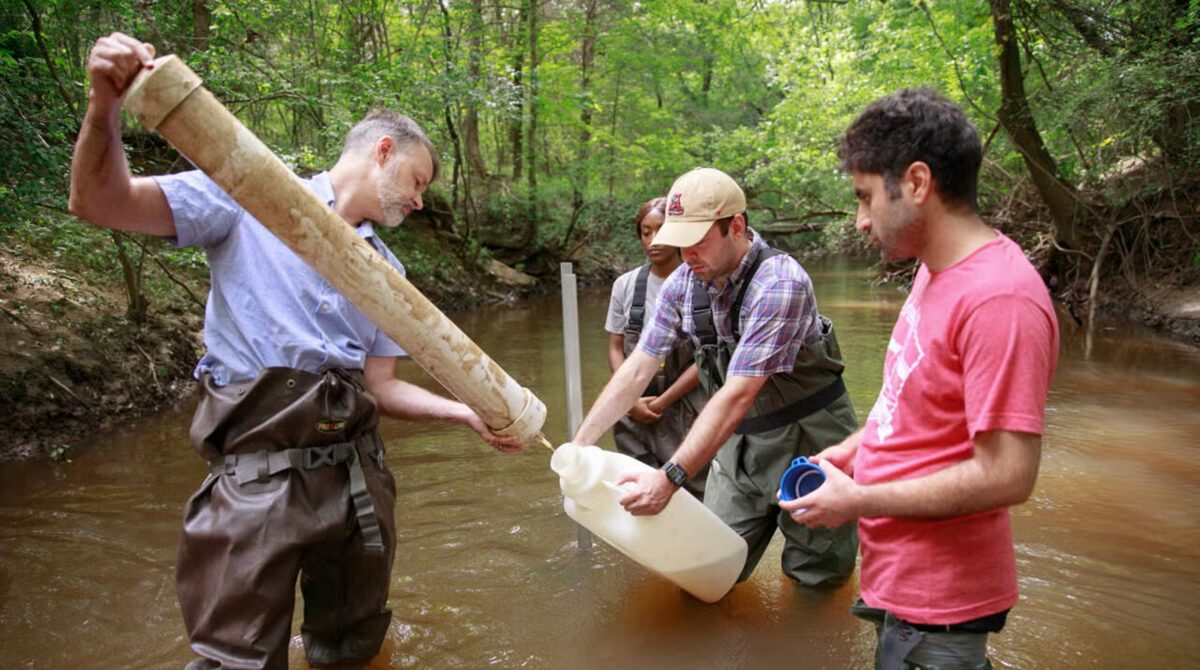Tom Hendrix is gone, but his wall lives on in Alabama

Trace Hendrix reflects on a stone bench in the Prayer Circle. (Anne Kristoff / Alabama NewsCenter)
There have been a lot of rock stars with ties to the Shoals area of Alabama, but none quite like Tom Hendrix. But unlike the Rolling Stones and the Black Keys, Hendrix’s medium was not rock music but rocks themselves. Or, more accurately, stones.
Hendrix garnered worldwide recognition for building a wall to honor his great-great grandmother, Te-lah-nay. She was a Yuchi Indian forced to leave her north Alabama home and walk the Trail of Tears path to Oklahoma. Leaving Alabama meant leaving her beloved Tennessee River. The Native Americans believed a woman lived in the river and sang to them, hence the nickname “The Singing River.” When Te-lah-nay didn’t hear singing in any of the waters in Oklahoma, she knew she had to return home.
Trace Hendrix shares his father’s legacy: The Wachahpi Commemorative Stone Wall in north Alabama from Alabama NewsCenter on Vimeo.
“Over 32 years ago, I had the great honor and privilege of sitting with one of my grandmother’s people. She changed my life,” Hendrix said in an interview with a visitor. “Her name was Minnie Long. I told her I wanted to do something for my grandmother. She said, ‘We shall all pass this Earth, only the stones will remain. We honor our ancestors with stones. That’s what you should do.’”
So that’s what he did.
The Wachahpi Commemorative Stone Wall, known as Tom’s Wall, was built to commemorate Te-lah-nay’s journey back to Alabama. According to Tom’s son, Trace, her path back was neither straight nor easy and it took about five years. She was just a teenager at the time, traveled all alone, and is the only person on record to have walked back home.
The wall is over a mile long and snakes around Hendrix’ property in rural Lauderdale County, near the Natchez Trace Parkway. It contains 8.5 million pounds of stone with no fill and no mortar. It is the largest memorial built in honor of a woman. Hendrix spent more than 33 years building the wall. He stopped adding to it a few years ago but was out there every day to greet a steady stream of visitors, recount Te-lah-nay’s story and answer questions about the process of creating the monument.
“It’s a very spiritual place,” said Trace Hendrix said. “It affects a lot of people in different ways.”
In addition to building The Wall, Tom tells the tale of Te-lah-nay’s journey in the book “If The Legends Fade.” Inside the front cover, the question is posed: “If the legends fade, who will teach the children?”
That question skyrocketed in significance earlier this year. The news of Tom Hendrix’ death in February spread quickly over social media, resulting in an immediate outpouring of heartfelt condolences and remembrances, and concerns about the future of the wall.
“I will continue to tell the stories,” said Trace, in his first interview since his father’s death. “It was a labor of love and the more I helped him do things, the more I understood it.”
In addition, Trace has a daughter and a nephew who are very interested in being involved.
Growing up, Trace says he always understood that the wall was his father’s calling and his passion. “It taught me that if you really want to do something you can do anything,” he said.
If you go:
The Wachahpi Commemorative Stone Wall is open every day from 8 a.m. – 4 p.m.
Trace plans to be there every Saturday and Sunday.
Location:
13890 County Road 8, Florence, AL 35633
In lieu of flowers, the family asks for donations to the Yuchi Language Project.































